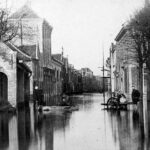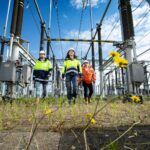
Syed Hasnain, de veelbesproken Indiase glacioloog, op wiens citaat in een New Scientist-artikel uit 1999 de IPCC-bewering gebaseerd bleek te zijn dat de gletsjers in de Himalaya in 2035 verdwenen zouden zijn, begint zich de afgelopen dagen te gedragen als de spreekwoordelijke kat in het nauw.
Vorige week was te lezen in New Scientist dat zijn opmerking destijds speculatie was geweest:
But Hasnain rejects that. He blames the IPCC for misusing a remark he made to a journalist. “The magic number of 2035 has not [been] mentioned in any research papers written by me, as no peer-reviewed journal will accept speculative figures,” he told New Scientist.
“It is not proper for IPCC to include references from popular magazines or newspapers,” Hasnain adds.
Maar deze week wordt het allemaal nog vreemder want plots ontkent Hasnain zelfs dat hij het jaartal 2035 überhaupt genoemd heeft en schuift hij de schuld dus in de schoenen van de journalist Fred Pearce, die hem verkeerd geciteerd zou hebben.
Jan. 20 (Bloomberg) — Syed Iqbal Hasnain, the Indian scientist credited with saying Himalayan glaciers may disappear by 2035, denied making the assertion published in the United Nations’ most comprehensive report on climate change.
The UN included the date in its 2007 assessment of global warming, citing a study by the environmental group WWF, which referenced a 1999 article in New Scientist magazine that quoted Hasnain. Today, he said: “I have not given any date or year on the likely disappearance of Himalayan glaciers.”
“I had simply told the New Scientist in an interview that the mass of the glaciers will decline in 40 years,” Hasnain said in a telephone interview. “The date (2035) was their invention. I was misquoted in the report.” The editorial team at New Scientist didn’t immediately respond today to an e-mailed request for comment.
Hasnain beweert dus dat hij ‘alleen maar’ had gezegd dat de gletsjers de komende veertig jaar zouden krimpen, een enorme afzwakking van zijn claim dat ze in 2035 volledig verdwenen zouden zijn. Maar we kunnen laten zien dat hij zelf toch met grote waarschijnlijkheid (laten we in IPCC-termen zeggen very likely) de bron van het jaartal 2035 is en ook de bron van het IPCC-rapport.
Strohalm
In 1999 publiceerde Hasnain een rapport voor het ICSI. Hij was op dat moment voorzitter van de werkgroep Himalayan Glaciology. Dit rapport rept inderdaad met geen woord over het jaar 2035 en die strohalm grijpt Hasnain daarom nu aan. Rond het uitkomen van het rapport verscheen er echter een artikel op de India Environmental Portal, waarin Hasnain aan het woord komt:
Glaciers in the Himalaya are receding faster than in any other part of the world and, if the present rate continues, the likelihood of them disappearing by the year 2035 is very high,” says the International Commission for Snow and Ice ( ICSI ) in its recent study on Asian glaciers. “But if the Earth keeps getting warmer at the current rate, it might happen much sooner,” says Syed Iqbal Hasnain of the School of Environmental Sciences, Jawaharlal Nehru University, New Delhi. Hasnain is also the chairperson of the Working Group on Himalayan Glaciology ( WGHG ), constituted in 1995 by the ICSI.
Nu kan je zeggen dat ook deze alinea geen 100% bewijs levert. Er staat een fout in want het dicht het jaartal 2035 toe aan het rapport. Het citaat daarna is wel echt van Hasnain en hij zegt daar dus zelfs dat het nog sneller kan gaan. Dit artikel verscheen twee maanden voor het nu gewraakte New Scientist-artikel. Hasnain doet er dus verstandig aan – als hij de ingezette lijn van ‘ik ben onjuist geciteerd’ wil voortzetten – dat hij ook de journalist van dit stuk beschuldigt van onjuist citeren. Hasnain was overigens de enige auteur van het ICSI-rapport, wat het nog waarschijnlijker maakt dat hij toch echt reageerde op het rapport. Het zal niet de eerste keer zijn dat wetenschappers in een persbijeenkomst of een interview een stapje verdergaan dan in hun oorspronkelijke – en vaak droge – artikel of rapport.
Frappante overeenkomst
Doet het fragment uit het artikel op de India Environmental Portal de lezer al ergens aan denken? Kijk eens naar de overeenkomsten met het IPCC-rapport:
Glaciers in the Himalaya are receding faster than in any other part of the world (see Table 10.9) and, if the present rate continues, the likelihood of them disappearing by the year 2035 and perhaps sooner is very high if the Earth keeps warming at the current rate. Its total area will likely shrink from the present 500,000 to 100,000 km2 by the year 2035 (WWF, 2005).
Het is overduidelijk dat eerst het WNF en later IPCC gewoon de bewerking ‘kopieer en plak’ hebben toegepast, gevolgd door een lichte eindredactie. Het IPCC-fragment is dus linea recta afkomstig van het april 1999 stuk op de India Environmental Portal waarin Hasnain zegt dat het zelfs sneller kan gaan met het verdwijnen van de gletsjers dan 2035.
Tegen Bloomberg zegt Hasnain over het feit dat hij nooit eerder had geklaagd dat hij verkeerd geciteerd was in New Scientist:
“I discovered much later that I had been misquoted. I didn’t even realize that the WWF was using the same New Scientist article. They referred to a New Scientist article, there was no mention of my name.”
Sommige wetenschappers bevinden zich het liefst in een ivoren toren, maar hoe waarschijnlijk is het dat een onderzoeker als Hasnain, die vrij gretig de media te woord staat, niet zou hebben geweten wat eerst de India Environmental Portal en later New Scientist aan hem toeschreef? In termen van het IPCC zou ik zeggen dat het almost certain is dat hij op de hoogte was.
Ik vond nog een interviewtje met Hasnain, opgenomen tijdens de top in Kopenhagen (ook een teken dat Hasnain geen ivoren toren-wetenschapper is). Hij zegt onder andere dat de gletsjers nog sneller smelten dan we vijf tot tien jaar geleden dachten. Maar hij noemt niet het jaar 2035. Zal hij het dan toch nooit gezegd hebben? :)






Marcel,
corrigeer je de spelfout weer even:
"dat hij ook de journalist van dit stuk beschuldigD van onjuist citeren."
Wederom goed stukje. Die meneer Hasnain staat nu behoorlijk buitenspel.
Foutje is aangepast. Marcel beter opletten! ;-)
'Turning Tide' heeft een mooie vondst:
If Hasnain was misquoted, as he is now claiming, I wonder why he permitted the Global Center's (TERI's) grant application to the Carnegie Foundation to say "One authoritative study reported that most of the glaciers in the region “will vanish within forty years as a result of global warming…resulting in widespread water shortages,” affecting not only the region’s drinking water, but irrigation for agriculture, hydropower capacity and industrial production."
This claim is available for anyone to read on the Carnegie Foundation's grants webpage.
If Hasnain was misquoted, and – crucially – was AWARE that he'd been misquoted, as he now says, why would he permit it the false claim to be repeated in this way?
I wonder if he'll be returning the $500,000 received in a grant from the Carnegie Foundation, since the money was granted on the basis of a false claim?
And I wonder if he'll be quitting from his job as head of TERI's glaciology team?
(2e reactie in de link, h/t Bishop Hill)
http://www.hindustantimes.com/Misquoted-says-man-…
@Harold: Wauw zeg! De community op deze site begint te leven! Dit zijn echt hele waardevolle vondsten die ook precies aansluiten bij de missie van deze site: Nederland een doorkijk bieden op de nasleep van de climategate… wat verder alleen in de Angelsaksische wereld echt leeft en voor krantenkoppen zorgt.
Met jouw vondst en Marcel's verhaal zit Hasnain echt klem. Misschien ga ik die Carnegie foundation eens bellen en vragen om commentaar! ;-)
Jongens, jullie zullen het allang wel weten, maar goud hier!
http://www.timesonline.co.uk/tol/news/environment…
En dan met name in dit stukje tekst:
Professor Hasnain, who was not involved in drafting the IPCC report, said that he noticed some of the mistakes when he first read the relevant section in 2008.
That was also the year he joined The Energy and Resources Institute (TERI) in Delhi, which is headed by Dr Pachauri.
He said he realised that the 2035 prediction was based on an interview he gave to the New Scientist magazine in 1999, although he blamed the journalist for assigning the actual date.
He said that he did not tell Dr Pachauri because he was not working for the IPCC and was busy with his own programmes at the time.
“I was keeping quiet as I was working here,” he said. “My job is not to point out mistakes. And you know the might of the IPCC. What about all the other glaciologists around the world who did not speak out?”
Bedankt trouwens voor jullie werk!
Pauchari heeft een are manier van redeneren.
“I need to consider what action to take, but that will take several weeks. It’s best to think with a cool head, rather than shoot from the hip.”
Hij maakt er geen probleem van om anderen te bekritseren als zij het niet hem eens zijn enhet meest belangrijk, zonder ook maar een greintje onderzoek te verrichten.
"Rajendra Pachauri, the chairman of the Intergovernmental Panel on Climate Change (IPCC), has described the Indian government report that criticized the claim by IPCC over the faster than expected melting of Himalayan glaciers, as “voodoo science”."
Pauchari komt meer en meer in een kwaad daglicht te staan, althans zijn uitspraken en overtuiging worden steeds minder gelooft. Hij is een politicus en derhalve behept met het "virus" om zijn ongelijk niet toe te geven, aan zijn ongelijk een positieve draai te geven of anderen de schuld te geven.
De "klimaatalarmisten" hebben een PR-probleem en de burger in de straat begint steeds meer te begrijpen dat het "probleem" wellicht helemaal geen probleem is of niet zo erg als door hen is voorgesteld.
Zojuist van de klimatosoof geplukt: van een meneer “Ook Boos” :
“Perpetual Oil
http://www.timesonline.co.uk/tol/news/environment…
Nu de Londen Times meerdere dagen aan een aan het hakken is geslagen, lijkt het wel alsof er continu olie op het brandend (helle) vuur van de alarmisten wordt geworpen.”
Het gaat om “iets” meer geld; ook van EU!
Dit is ook een interessante nieuwe ontwikkeling. Een "wetenschapper" die terugslaat.
Glacier scientist: I knew data hadn't been verified
By David Rose / Daily Mail
The scientist behind the bogus claim in a Nobel Prize-winning UN report that Himalayan glaciers will have melted by 2035 last night admitted it was included purely to put political pressure on world leaders.
Dr Murari Lal also said he was well aware the statement, in the 2007 report by the Intergovernmental Panel on Climate Change (IPCC), did not rest on peer-reviewed scientific research.
In an interview with The Mail on Sunday, Dr Lal, the co-ordinating lead author of the report’s chapter on Asia, said: ‘It related to several countries in this region and their water sources. We thought that if we can highlight it, it will impact policy-makers and politicians and encourage them to take some concrete action.
http://www.dailymail.co.uk/news/article-1245636/G…
Zie ook WUWT.
We moeten nog wel een voorbehoud maken en kijken of het interview door andere kranten wordt bevestigd en de uitspraak niet door Lal wordt weersproken.
Wat me nog meer opvalt is, dat in dat stuk van de daily mail dit wordt gezegd van pachauri en lai: pachauri zegt dat lai z´n werk niet goed gedaan heeft, en lai zegt, dat zoals het werk gedaan is, dus fout, wél volgens de richtlijnen van het ipcc was..
"Having been forced to apologise over the 2035 claim, Dr Pachauri blamed Dr Lal, saying his team had failed to apply IPCC procedures.
It was an accusation rebutted angrily by Dr Lal. ‘We as authors followed them to the letter,’ he said. ‘Had we received information that undermined the claim, we would have included it.’
Vraag is dan natuurlijk welke procedure lai naar de letter gevolgd heeft: het toestaan van ontkrachtende comments, of het toestaan van grey niet peer reviewed literatuur?
Grey werd dus toegestaan, en kritiek ook, maar genegeerd.
Want dan gaat het verder, dat er wel comments geleverd waren door reviewers, iets van 500, maar dat geen daarvan in het eindrapport belandde.
De draft was hetzelfde als de uiteindelijke tekst.
Peer reviewed ?
"However, an analysis of those 500-plus formal review comments, to be published tomorrow by the Global Warming Policy Foundation (GWPF), the new body founded by former Chancellor Nigel Lawson, suggests that when reviewers did raise issues that called the claim into question, Dr Lal and his colleagues simply ignored them.
For example, Hayley Fowler of Newcastle University, suggested that their draft did not mention that Himalayan glaciers in the Karakoram range are growing rapidly, citing a paper published in the influential journal Nature.
In their response, the IPCC authors said, bizarrely, that they were ‘unable to get hold of the suggested references’, but would ‘consider’ this in their final version. They failed to do so."
Bizar.
Read more: http://www.dailymail.co.uk/news/article-1245636/G…
En dit is wellicht een geheel nieuwe ontwikkeling.
"UN wrongly linked global warming to natural disasters"
THE United Nations climate science panel faces new controversy for wrongly linking global warming to an increase in the number and severity of natural disasters such as hurricanes and floods.
It based the claims on an unpublished report that had not been subjected to routine scientific scrutiny — and ignored warnings from scientific advisers that the evidence supporting the link too weak. The report's own authors later withdrew the claim because they felt the evidence was not strong enough.
http://www.timesonline.co.uk/tol/news/environment…
Via commenter JimChip op CA.
Maar even wat anders.
Zie eens wat haisnain vóór kopenhagen, 4 dec, zei tegen time magazine,(time.com):Alarmisme ten top !
" For Hasnain, who has devoted his career to studying the dynamics of Himalayan ice, establishing a firm benchmark will help clear up the uncertainty that still clouds the subject. But he has little doubt that the glaciers are melting fast, and he knows saving them will be vital for India, as well as the rest of Asia and the world. That will mean reducing carbon emissions. "The debate is over," he says. "We know the science. We see the threat. The time for action is now."
http://www.time.com/time/specials/packages/articl…
gezien via http://nofrakkingconsensus.blogspot.com/2010/01/t…
Die Haisnain is een beetje gek hé ? Nu e.e.a. ontkennend en z´n straaje schoonvegend, maar tot vlak voor kopenhagen was ie puur alarmistisch bezig..
Rare jongens, die alarmisten
Dit is OT maar ik kan het toch niet laten.
Volgens de Carnegie Corporation was het doel van die $500.000: "One-time funding toward research, analysis and training on water-related security and humanitarian challenges to South Asia posed by melting Himalaya glaciers"
Volgens een recente officiële TERI verklaring zit het zo: "The Global Centre, Iceland received support from Carnegie Foundation for glacier related work. Our collaboration with this Centre is for the purpose of training and teaching in glaciology."
Maar op 15/01/09 was het verhaal: "Under this collaboration, senior scientists from the respective countries will carry expeditions in the Himalayas. The collaboration, which is its early stage, will be funded primarily by the Carnegie Corporation of New York."
In datzelfde persbericht staat ook: " TERI has initiated the establishment of Glacier Monitoring Observatories at Kolahoi Glacier, Jammu and Kashmir and another at East Rathong Glacier, Sikkim. These two glaciers are being monitored with the state-of-art scientific instruments on a regular basis for various parameters like Energy Balance, Mass Balance and Hydrological Balance for the glacierized region." (de metingen zijn geautomatiseerd)
Kort samengevat: Op basis van een onjuiste claim wordt er geld beschikbaar gesteld door de Carnegie Foundation voor "training and teaching in glaciology". Dat "training and teaching in glaciology" houdt in dat oudere wetenschappers een snoepreisja/himalaya expeditie krijgen.
Bah, deze vondst was al gedaan door Richard North.
http://eureferendum.blogspot.com/2010/01/contradi…
Update: dat Carnegie geld is (al een tijdje) stopgezet.
http://eureferendum.blogspot.com/2010/02/carnegie…